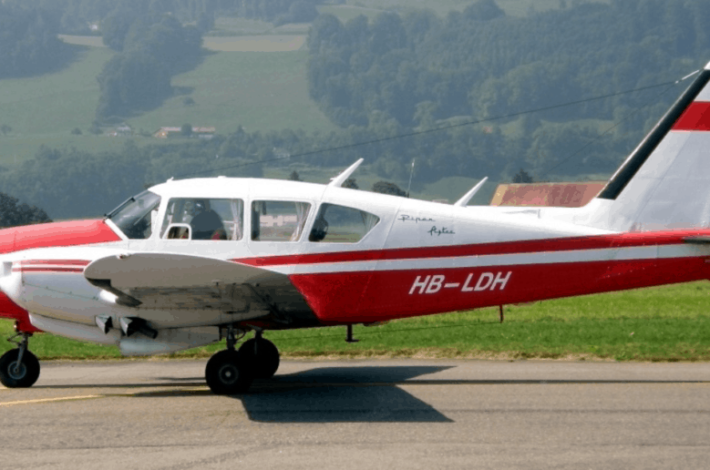
The Piper PA 23 Aztec, which debuted in 1962 was introduced as an improved alternative, to its predecessor, the ‘Apache.’ It featured power with its 250 horsepower aspirated Lycoming engines. With a swept tail and the ability to accommodate five individuals it offered a step up in performance. Its production continued until 1982 evolving through series from A to F.
- After its initial release the Aztec B series made its entrance in late 1962. This upgraded version boasted seating for six people along with an elongated nose and several system modifications;
- As time went on the Aztec D received updates to its control and instrument panel while the Aztec E showcased a single piece windshield and a lengthened pointed nose. The final model in 1976 was the F series, which underwent enhancements to its systems. Additionally it featured cambered wingtips and extensions to the tail plane tips.
Over two decades of production 5,000 aircraft were manufactured under the Piper Aztec name. Among those who had the opportunity to fly it the affectionate nickname ‘Aztruck’ emerged. Although not particularly outstanding in any category this aircraft excelled as a load hauler. It offered a cabin, flight characteristics, impressive performance on short field operations and satisfactory fuel efficiency. These qualities allowed it to carve out a position within its class.
Piper PA 23 250 Prices
Upon its release, the Aztec carried a price of roughly US$49,000. When the F series made its debut in 1971 the price saw an increase to around US$69,000. Nowadays the cost varies significantly based on factors like the model, total flight hours and engine condition. Typically maintained A or B models with an approximate total airframe time of 4,000 hours and engines with extensive use can be found in the price range of US$55,000 to US$75,000. Conversely F models featuring flight hours and engines with usage tend to sell for approximately US$175,000. The average price range generally falls between US$85,000 and US$99,000.
Piper PA 23 250 Performance & Handling
The Aztec, with its wing profile to that of the Piper Cub offers an comfortable flying experience without unnecessary frills. Its high lift wing allows it to carry a fuel load and accommodate six passengers making it an excellent choice for transporting loads. Additionally it serves as an twin engine aircraft for pilots with limited flight experience. The Aztec also impresses with a VMC (minimum control speed on the ground) of 80 knots and a stall speed of 60 knots.
As an aircraft designed for flight rules (IFR) operations the control forces in roll and yaw give a feeling while those in pitch are more manageable. The design of the Aztec emphasizes functionality over speed thanks to its lift wing and rounded shape. Consequently it does not boast velocity capabilities. Taking the F model for example it maintains a cruise speed of 176 knots. Never exceeds 222 knots. When cruising at altitudes you can expect the true airspeed to hover around 155 to 165 knots. Fuel consumption during this phase remains reasonable averaging between 25 to 29 gallons, per hour at 76% power.

Single-Engine Performance and Maintenance
The single-engine performance of the Aztec, particularly in the F series, is quite poor, with a rate of climb reaching only 230 feet per minute on a favorable day.
Pa23-250 Maintenance and Schedule
When properly maintained, the Piper Aztec requires maintenance similar to other light twin-engine aircraft. Basic inspections are conducted every 100 hours, with mandatory annual inspections. The engines have a recommended time between overhauls (TBO) of 2,000 hours, while the propellers require attention at 2,400 hours. Since the aircraft is of a certain age, there are numerous airworthiness directives (AD) to comply with.
Pa23-250 Modifications and Upgrades
For owners seeking modifications for their Aztec, Diamond Aire in Montana specializes in various enhancements.
MICRO Aerodynamics provides a micro vortex generator kit for the Aztec wings, which reduces the VMC (minimum control speed) and stall speeds. Another potential upgrade is the Robertson R-STOL kit, improving landing and take-off performance, enhancing safety with slower speeds, crisper handling, and lower power requirements during takeoff and climb-out. Additionally, Met-Co-Aire in California manufactures and markets modifications to increase the fuel tip-tank capacity.
Hartzell, a propeller manufacturer, has released a new scimitar two-blade propeller that can add an extra 2 knots to the Aztec’s speed.
Pa23-250 Insurance Options
For a private pilot with 1,000 hours of total flight time, an IFR/MEL rating, and 250 hours on multi-engine aircraft, the annual cost of US$1,000,000 liability coverage in 2021 ranges from US$900 to US$1,150. Pilots with less experience can expect higher premiums, ranging from US$1,100 to US$1,375 per year. If additional hull coverage of US$90,000 is included, annual premiums for experienced pilots range from US$1,985 to US$2,240, while less experienced pilots can expect to pay US$2,910 to US$3,760 per year.
Pa23-250 Model Resale Value
Several factors influence the resale value of the Aztec, including airframe total hours, engine hours since overhaul, installed equipment (especially avionics), compliance with maintenance schedules, damage history, paint condition, and interior condition. Owners have control over these factors, and those who prioritize maintenance can expect to preserve higher resale value. Aztecs in reasonable condition typically command prices between US$90,000 and US$100,000. However, the overall demand for twin-engine aircraft is uncertain, with a significant decrease in production compared to previous decades. This unpredictability can impact future resale values.
Pa23-250 Owner Reviews
Based on owner reviews, the Aztec receives positive feedback. Owners describe it as a large, heavy, stable, and roomy aircraft. They praise its ease of flying and stable performance during instrument flights. Many owners appreciate the lower capital cost of the Aztec compared to more expensive high-end single-engine aircraft like the Piper Saratoga or Cessna Centurion. While operating costs are lower, the Aztec provides system redundancy as an additional benefit.
Owners report cruise speeds ranging from 170 to 185 knots on 27 gallons per hour of fuel consumption at lower altitudes. Annual maintenance costs vary between US$2,500 and US$1,500, depending on the age and condition of the aircraft. Insurance costs are a common concern among owners, and obtaining an instrument rating is recommended to reduce annual premiums. Overall, owners view the Aztec as an affordable, comfortable, and capable twin-engine aircraft that meets their needs well.
Pa23-250 Similar Aircraft
These aircraft generally fall within the same price range and offer comparable specifications. However, the Aztec stands out for its consistency across various performance aspects. While other models may excel in specific areas, the Aztec provides a solid performance across service ceiling, cruise speed, short-field performance, cabin space, and impressive load-lifting capability. Therefore, if a well-rounded aircraft is desired, particularly for stable instrument flight and transporting heavy loads to and from short fields, the Aztec is an excellent choice.
To wrap up
In conclusion, the Piper PA 23 Aztec stands as a notable aircraft in the aviation industry, offering a unique combination of capabilities and characteristics. Its 20-year production span and nearly 5,000 units manufactured reflect its success in the market. While not exceptional in any specific category, the Aztec’s strength lies in its role as a reliable load-hauler with a spacious cabin and acceptable fuel economy. Owners appreciate its stability during instrument flights and its cost-effectiveness compared to higher-end single-engine aircraft.
- Maintenance and modifications play significant roles in maximizing the Aztec’s performance and value. Regular inspections and compliance with maintenance schedules are essential for maintaining the aircraft’s airworthiness. Various modifications and upgrades are available to enhance its capabilities, ranging from instrument panel improvements to wing tip modifications and engine enhancements. Furthermore, the availability of replacement parts from aircraft wreckers ensures continued support for Aztec owners.
- Resale value and insurance considerations are crucial factors for potential buyers and owners. Proper maintenance and compliance with scheduled inspections contribute to maintaining the aircraft’s value over time. Insurance premiums vary based on the pilot’s experience and coverage options, making it important to assess individual needs and circumstances.
- While the Aztec faces some challenges, such as single-engine performance limitations and potential fuel tank issues, its overall reputation remains favorable among owners. Its consistent performance, combined with its load-lifting capabilities, spacious cabin, and stability during instrument flights, makes it a reliable choice for pilots seeking a versatile twin-engine aircraft.
Comparable aircraft in the market offer similar specifications but may excel in specific areas. However, the Aztec’s well-rounded performance, especially in short-field operations and load-carrying capacity, sets it apart from the competition. The future resale value of twin-engine aircraft remains uncertain, but with proper maintenance and care, the Aztec is expected to retain its value well if looked after and appropriately maintained. In the end, the Piper PA 23 Aztec continues to be favored by pilots who appreciate its affordability, comfort, and versatility. Its reputation as a capable, stable, and reliable aircraft remains strong, making it a preferred choice for training, first-time twin conversions, and various missions requiring load-carrying capabilities.